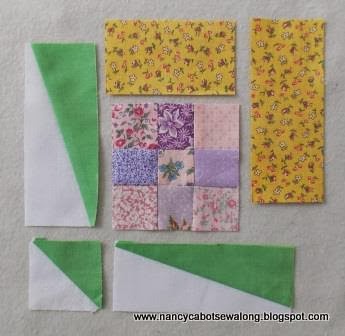 |
| Bachelor's Puzzle |
Nancy Cabot wrote about this block, "A quilt of this design would be appreciated by any young man as a fitting bit of interior decoration for his room, as well as providing a comfortable warmth."
This simple geometric quilt block was to be made of "plain blue and white materials combined with a matching blue print."
There is a Bachelor's Puzzle pattern published by The Progressive Farmer here that looks just like Nancy Cabot's drawing from the Chicago Tribune.
To make this block using today's techniques, I am sure I used more pieces than in 1933 when it was likely that the pieces were sewn by hand. These are the parts I used-
The center is a 3 1/2" square of white fabric with 2" squares sewn on the diagonal and flipped at each of the four corners. The white squares are cut at 2". The half square triangles are 2" square and will finish at 1 1/2" when sewn into the block. Note that there are two sets of half square triangles.
You can see a very scrappy version of a Bachelor's Puzzle quilt here. The block goes in the opposite direction! This one uses the traditional blue and white scheme and is set with sashing and cornerstones.
A picture of the Bachelor's Puzzle block is shown in a leaflet from 1933 published for J.&P. Coats Thread here. Notice that it is called Box Quilt or Road to Jerusalem. The first image is the front of the leaflet. The second image is a page entitled Directions For Making "Heirloom Quilts." The picture of the block is at the bottom of the page.
Tomorrow-Wreath of Daisies










































